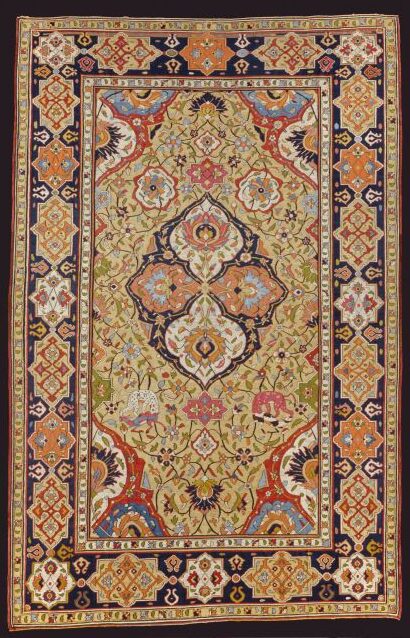Weaving Splendor: Treasures of Asian Textiles
from The Nelson-Atkins Museum of Art
October 7, 2022–January 2, 2023

NASHVILLE, Tenn. (August 17, 2022)—The Frist Art Museum presents Weaving Splendor: Treasures of Asian Textiles from The Nelson-Atkins Museum of Art, an exhibition of Chinese, Indian, Japanese, Persian, and Turkish textiles drawn from one of the most significant collections of Asian art in the United States. Organized by The Nelson-Atkins Museum of Art in Kansas City, the exhibition will be on view in the Frist’s Ingram Gallery from October 7, 2022 through January 2, 2023.
Made with precious materials, innovative techniques, and stunning artistry, Asian textiles have been integral to global trade for centuries. Whether woven from cotton, linen, silk, or wool, each textile in Weaving Splendor tells a complex and fascinating story that leads guests on a journey along trade routes across continents, and through time, from the 15th century to today.
“This exhibition provides a rare opportunity for our audiences, since these extraordinary treasures are not often displayed due to their fragile and light-sensitive nature,” says Frist Art Museum senior curator Trinita Kennedy. “Not only will our guests gain a deeper understanding of the diverse historical textiles on view, but they will also learn about how Asian traditions are being practiced and kept alive today, including by artists in our own community through in-gallery demonstrations.”
With more than 65 objects organized thematically into five sections, Weaving Splendor explores the various purposes for which Asian textiles have been created, including for use as garments, furnishings, gifts, and trade goods. Formal court robes made in imperial China and Japan signified rank and status within the governmental hierarchy, while striking costumes from Japanese theater traditions and Chinese operas brought characters from illusionary worlds to life on stage. Textured velvets and exquisite furniture covers defined and transformed interior spaces. In a recreation of a royal 16th-century Persian tent, exhibition guests can be enveloped by magnificent silk velvet ornamented with flowers and scenes of a royal hunt.
A section devoted to the major role Asian textiles played in diplomatic exchange and global trade features Indian pashmina shawls and chintzes and Persian carpets, including one commissioned as gift by a shah to a pope around 1600. “Carpets woven in the Islamic world were highly prized in Renaissance Europe. This spectacular example remains in excellent condition, which suggests that it might have been displayed on a wall or table rather than walked upon,” explains Kennedy.

The exhibition concludes with modern and contemporary textiles from China, Japan, India, Pakistan, and Turkey. In some areas, traditions, have been revived by nongovernmental agencies and dedicated patrons and artists, while art forms such as carpet weaving have continued in other regions without interruption. In the 21st century, Asia has regained its position as both a leading textile producer and as a place where local traditions of domestic and luxury textile making continue to thrive.
In addition to experiential learning activities in the Martin ArtQuest® Gallery, Weaving Splendor is complemented by an education gallery with illustrated reference books, a place for guests to reflect and respond, and an area where contemporary fiber artists will talk about and show their processes. A schedule of live demonstrations will be updated at FristArtMuseum.org and will also be available on a touch screen in the gallery.
Programs
Thursday, October 6
Curators’ Perspectives: Textile Treasures from Asia in Weaving Splendor
6:30–7:30 p.m.
Auditorium
Free; first come, first seated
Presented by Ling-en Lu, Curator of Chinese art; Kimberly Masteller, Jean McCray Beals Curator of South and Southeast Asian Art; and Yayoi Shinoda, Assistant Curator of Japanese art, The Nelson-Atkins Museum of Art
The world has always turned to Asia for luxurious textiles. In this special presentation about fine textiles and garments from The Nelson-Atkins Museum of Art, guests will have an opportunity to see why. Join Nelson-Atkins curators Ling-en Lu, Kimberly Masteller, and Yayoi Shinoda for a close examination of some of the sumptuous textile treasures from across Asia featured in Weaving Splendor.
At this lecture, attendees will be introduced to works ranging from intimate objects worn on the body to objects that define and enliven interior spaces, to dynamic costumes that support narratives in performances, to symbol-laden objects that communicate power and wealth. Each one of these works reveals a fascinating story, including a golden robe made for a Chinese prince of the Qing dynasty, a silk carpet created by the ruler of Persia as a gift to the pope in Rome, and monumental Japanese tapestries produced for Western consumption around the turn of the twentieth century.
Exhibition Credit
Organized by The Nelson-Atkins Museum of Art, Kansas City, Missouri
Image Credits
1. Japan, Edo period (1615–1868). Kyōgen costume (suō-type), first half of the 19th century. Asa (bast fiber) with stencil dyeing; 41 1/2 x 82 1/2 in. The Nelson-Atkins Museum of Art, Purchase: William Rockhill Nelson Trust, 31 -142/60
2. China (Ming dynasty, 1368–1644). Chair cover (detail), 17th century. Kesi (silk tapestry) woven with silk and metallic threads; 20 3/8 x 63 3/4 in. The Nelson- Atkins Museum of Art, Gift of Mr. and Mrs. Earl Morse, 59-18/5
3. Chinese (Qing dynasty, 1644–1911). Flag for theater, 17th–18th centuries. Silk and metallic thread embroidery on silk satin; 70 x 91 in. The Nelson-Atkins Museum of Art, Purchase: William Rockhill Nelson Trust, 32-187/2
Supporter Acknowledgment
Platinum Sponsor: HCA Healthcare/TriStar Health
Hospitality Sponsor: Union Station Hotel
Spanish Translation Sponsor: Center for Latin American, Caribbean, and Latinx Studies at Vanderbilt University
Funded in part by Hays Foundation
Supported in part by Judy and Joe Barker
The Frist Art Museum is supported in part by The Frist Foundation, Metro Arts, the Tennessee Arts Commission, and the National Endowment for the Arts.
Connect with us @FristArtMuseum #TheFrist #FristWeavingSplendor
FOR ADDITIONAL INFORMATION
Buddy Kite: 615.744.3351, bkite@FristArtMuseum.org
Ellen Jones Pryor: 615.243.1311, epryor@FristArtMuseum.org
